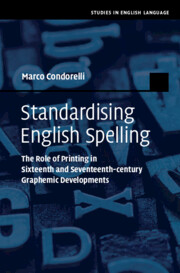 Standardising English Spelling
Standardising English Spelling from Part III - Case Studies
Published online by Cambridge University Press: 31 March 2022
Chapter 10 focuses on the standardisation of vowel diacritic spelling, and especially groups of graphemes indicating vowel quality and vowel quantity. Between the sixteenth and the seventeenth centuries, <ea˃ and <oa˃, indicating vowel quality, as well as <dg> and <g>, <tch> and <ch>, and <k> and <ck>, for vowel quantity, shifted from an early distribution principle to a new, modern standard. The results show a modern development that lasted throughout most of the sixteenth century, both in the two digraphs and in the consonantal alternants. By the seventeenth century, the uses of vowel diacritic spelling appear to have crystallised despite later ongoing vocalic developments in Early Modern English. The changes in the sets of graphemes investigated occurred uniformly across two generations, both at vocabulary level, encompassing high-frequency and low-frequency words concurrently, and also across most of the spelling units analysed. As for all the other case studies, my results indicate that there may have been a pragmatic agent behind the modern developments in vowel diacritic spelling.
To save this book to your Kindle, first ensure [email protected] is added to your Approved Personal Document E-mail List under your Personal Document Settings on the Manage Your Content and Devices page of your Amazon account. Then enter the ‘name’ part of your Kindle email address below. Find out more about saving to your Kindle.
Note you can select to save to either the @free.kindle.com or @kindle.com variations. ‘@free.kindle.com’ emails are free but can only be saved to your device when it is connected to wi-fi. ‘@kindle.com’ emails can be delivered even when you are not connected to wi-fi, but note that service fees apply.
Find out more about the Kindle Personal Document Service.
To save content items to your account, please confirm that you agree to abide by our usage policies. If this is the first time you use this feature, you will be asked to authorise Cambridge Core to connect with your account. Find out more about saving content to Dropbox.
To save content items to your account, please confirm that you agree to abide by our usage policies. If this is the first time you use this feature, you will be asked to authorise Cambridge Core to connect with your account. Find out more about saving content to Google Drive.